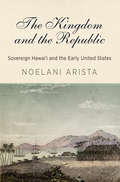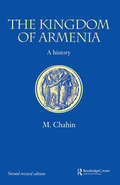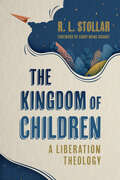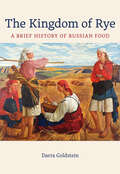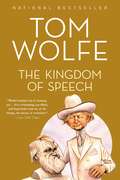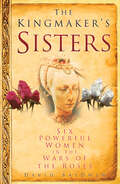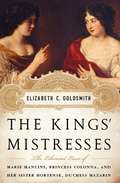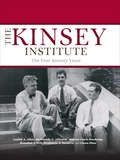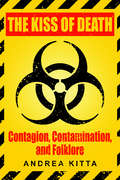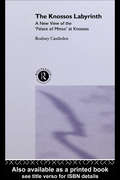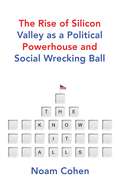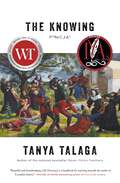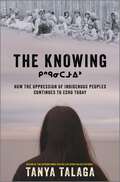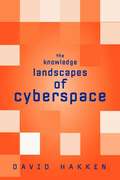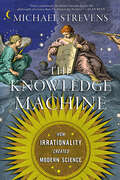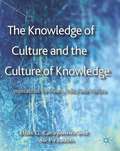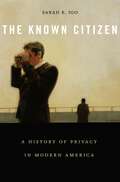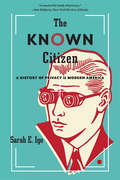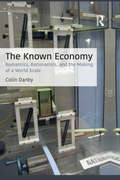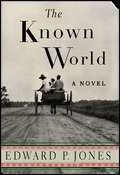- Table View
- List View
The Kingdom and the Republic: Sovereign Hawai'i and the Early United States (America in the Nineteenth Century)
by Noelani AristaIn 1823, as the first American missionaries arrived in Hawaiʻi, the archipelago was experiencing a profound transformation in its rule, as oral law that had been maintained for hundreds of years was in the process of becoming codified anew through the medium of writing. The arrival of sailors in pursuit of the lucrative sandalwood trade obliged the aliʻi (chiefs) of the islands to pronounce legal restrictions on foreigners' access to Hawaiian women. Assuming the new missionaries were the source of these rules, sailors attacked two mission stations, fracturing relations between merchants, missionaries, and sailors, while native rulers remained firmly in charge.In The Kingdom and the Republic, Noelani Arista (Kanaka Maoli) uncovers a trove of previously unused Hawaiian language documents to chronicle the story of Hawaiians' experience of encounter and colonialism in the nineteenth century. Through this research, she explores the political deliberations between aliʻi over the sale of a Hawaiian woman to a British ship captain in 1825 and the consequences of the attacks on the mission stations. The result is a heretofore untold story of native political formation, the creation of indigenous law, and the extension of chiefly rule over natives and foreigners alike.Relying on what is perhaps the largest archive of written indigenous language materials in North America, Arista argues that Hawaiian deliberations and actions in this period cannot be understood unless one takes into account Hawaiian understandings of the past—and the ways this knowledge of history was mobilized as a means to influence the present and secure a better future. In pursuing this history, The Kingdom and the Republic reconfigures familiar colonial histories of trade, proselytization, and negotiations over law and governance in Hawaiʻi.
The Kingdom of Armenia: New Edition (Caucasus World)
by Mack ChahinWhile the majority of contemporary works on Armenia concentrate on the modern era, The Kingdom of Armenia takes its beginning in the third century BC, with the ancient literate peoples of Mesopotamia who had commercial interests in the land of Armenia, and continues with a comprehensive overview through to the end of the Middle Ages.
The Kingdom of Children: A Liberation Theology
by R. L. StollarEmpower the children in your faith community. Children are marginalized in our churches, dismissed into Sunday school or silenced for lengthy sermons aimed at adults. R. L. Stollar has spent his career advocating for the rights of children, and he thinks it&’s time to stop talking down to children and start listening to them.In The Kingdom of Children, Stollar proposes a liberation theology of the child. Stollar begins with a theoretical framework that centers children in our theology and ecclesial life. Reframing biblical stories to center children, we can see how the binding of Isaac reflects the spiritual effects of child abuse, or how children like Miriam can serve as leaders in their communities. Using scriptural examples as well as real studies of children&’s spiritual lives, Stollar asserts that children can be priests, prophets, and theologians in our communities. Each chapter concludes with activities and discussion points for introducing the book&’s concepts to children.The Kingdom of Children is a must-read for youth ministers, parents, and anyone who works with children. By embracing the liberation of children, we can avoid stunting their spiritual growth and passing on trauma. And when we lift up children—truly value and learn from them—we build up the kingdom of God here in our communities.
The Kingdom of Rye: A Brief History of Russian Food (California Studies in Food and Culture #77)
by Darra GoldsteinCelebrated food scholar Darra Goldstein takes readers on a vivid tour of history and culture through Russian cuisine. The Kingdom of Rye unearths the foods and flavors of the Russian land. Preeminent food studies scholar Darra Goldstein offers readers a concise, engaging, and gorgeously crafted story of Russian cuisine and culture. This story demonstrates how national identity is revealed through food—and how people know who they are by what they eat together. The Kingdom of Rye examines the Russians' ingenuity in overcoming hunger, a difficult climate, and a history of political hardship while deciphering Russia's social structures from within. This is a domestic history of Russian food that serves up a deeper history, demonstrating that the wooden spoon is mightier than the scepter.
The Kingdom of Speech
by Tom Wolfe<P>The maestro storyteller and reporter provocatively argues that what we think we know about speech and human evolution is wrong. <P>Tom Wolfe, whose legend began in journalism, takes us on an eye-opening journey that is sure to arouse widespread debate. THE KINGDOM OF SPEECH is a captivating, paradigm-shifting argument that speech--not evolution--is responsible for humanity's complex societies and achievements. <P>From Alfred Russel Wallace, the Englishman who beat Darwin to the theory of natural selection but later renounced it, and through the controversial work of modern-day anthropologist Daniel Everett, who defies the current wisdom that language is hard-wired in humans, Wolfe examines the solemn, long-faced, laugh-out-loud zig-zags of Darwinism, old and Neo, and finds it irrelevant here in the Kingdom of Speech. <P><b>A New York Times Bestseller</b>
The Kingdom of Toro in Uganda (Routledge Revivals)
by Kenneth InghamFirst published in 1975, The Kingdom of Toro in Uganda describes the foundation of the Toro kingdom in the nineteenth century by the rebel prince Kaboyo, and investigates how Kasagama, Kaboyo’s grandson, was able to recreate, with little local support, a kingdom far more extensive than Kaboyo had ever envisaged. His personal authority was established by his insistence that its root were traditional, thus satisfying the requirements of ‘indirect rules’ at a time when this ill-defined concept served both as the shibboleth and the escape clause for an overstretched British colonial administration. Although Kasagama’s son, Rukidi, was able to combine authority with personal popularity and to take advantage of colonial innovations without losing control of his kingdom, the ending of colonial rule brought an end to Toro as he knew it. In an independent Uganda the particularism stressed by Toro’s rulers could not survive. This book will be of interest to students of history, colonialism, African studies and ethnic studies.
The Kingdoms of Laos
by Sanda SimmsDescribes the changes in society over 600 years as Lan Xang was gradually dismembered and became a French colony. Most importantly, it shows the essence of the Lao and why, despite all that has happened, they possess their own social and cultural values that mark them as distinctive.
The Kingmaker's Sisters: Six Powerful Women in the Wars of the Roses
by David BaldwinWarwick the Kingmaker, the Earl of Warwick & Salisbury whose wealth and power was so great that he could effectively decide who would rule England during the Wars of the Roses (1455-1487), had six sisters: Joan, Cecily, Alice, Eleanor, Katherine and Margaret. They all married powerful noblemen who fought on opposing sides during this turbulent period.The Kingmaker's Sisters examines the role that they played in late fifteenth-century England, as wives, mothers and homemakers, but also as deputies for their absent husbands, and how the struggle between the Yorkists and the Lancastrians affected them and their families. Scholarly but accessible, this is the first history of the Wars of the Roses to be written from this perspective, and will appeal to general readers, historians of the period and those with an interest in feminist history.
The Kings' Mistresses: The Liberated Lives of Marie Mancini, Princess Colonna, and Her Sister Hortense, Duchess Mazarin
by Elizabeth GoldsmithThe Mancini Sisters, Marie and Hortense, were born in Rome, brought to the court of Louis XIV of France, and strategically married off by their uncle, Cardinal Mazarin, to secure his political power base. Such was the life of many young women of the age: they had no independent status under the law and were entirely a part of their husband's property once married. Marie and Hortense, however, had other ambitions in mind altogether. Miserable in their marriages and determined to live independently, they abandoned their husbands in secret and began lives of extraordinary daring on the run and in the public eye. The beguiling sisters quickly won the affections of noblemen and kings alike. Their flight became popular fodder for salon conversation and tabloids, and was closely followed by seventeenth-century European society. The Countess of Grignan remarked that they were traveling "like two heroines out of a novel. " Others gossiped that they "were roaming the countryside in pursuit of wandering lovers. " Their scandalous behavior--disguising themselves as men, gambling, and publicly disputing with their husbands--served as more than just entertainment. It sparked discussions across Europe concerning the legal rights of husbands over their wives. Elizabeth Goldsmith's vibrant biography of the Mancini sisters--drawn from personal papers of the players involved and the tabloids of the time--illuminates the lives of two pioneering free spirits who were feminists long before the word existed.
The Kinsey Institute: The First Seventy Years (Well House Bks.)
by Judith A. Allen Andrew Clark-Huckstep Brandon J. Hill Hallimeda E. Allinson Liana Zhou Stephanie A. SandersAn in-depth history of Alfred Kinsey&’s groundbreaking Institute for Sex Research and the cultural awakening it inspired in America—&“it has no rival&” (Angus McLaren). While teaching a course on Marriage and Family at Indiana University, biologist Alfred Kinsey noticed a surprising dearth of scientific literature on human sexuality. He immediately began conducting his own research into this important yet neglected field of inquiry, and in 1947, founded the Institute for Sex Research as a firewall against those who opposed his work on moral grounds. His frank and dispassionate research shocked America with the hidden truths of our own sex lives, and his two groundbreaking reports —Sexual Behavior in the Human Male (1948) and Sexual Behavior in the Human Female (1953)—both became New York Times bestsellers. In The Kinsey Institute: The First Seventy Years, Judith A. Allen and her coauthors provide an in-depth history of Kinsey&’s groundbreaking work and explore how the Institute has continued to make an impact on our culture. Covering the early years of the Institute through the &“Sexual Revolution,&” into the AIDS pandemic of the Reagan era, and on into the &“internet hook-up&” culture of today, the book illuminates the Institute&’s enduring importance to society.
The Kiss of Death: Contagion, Contamination, and Folklore
by Andrea KittaDisease is a social issue, not just a medical issue. Using examples of specific legends and rumors, The Kiss of Death explores the beliefs and practices that permeate notions of contagion and contamination. Author Andrea Kitta offers new insight into the nature of vernacular conceptions of health and sickness and how medical and scientific institutions can use cultural literacy to better meet their communities’ needs. Using ethnographic, media, and narrative analysis, this book explores the vernacular explanatory models used in decisions concerning contagion to better understand the real fears, risks, concerns, and doubts of the public. Kitta explores immigration and patient zero, zombies and vampires, Slender Man, HPV, and the kiss of death legend, as well as systematic racism, homophobia, and misogyny in North American culture, to examine the nature of contagion and contamination. Conversations about health and risk cannot take place without considering positionality and intersectionality. In The Kiss of Death, Kitta isolates areas that require better communication and greater cultural sensitivity in the handling of infectious disease, public health, and other health-related disciplines and industries.
The Kitchen without Borders: Recipes and Stories from Refugee and Immigrant Chefs
by The Eat Offbeat ChefsRefugees by status, chefs by calling.The Kitchen Without Borders is a special kind of cookbook. In it, chefs from around the world – all part of Eat Offbeat, a catering company staffed by immigrants and refugees who have found a new home and new hope through cooking- offer up to 70 authentic, surprising, nourishing recipes. The food has roots that run as deep as its flavors, celebrating the culinary traditions of Syria, Iran, Eritrea, Venezuela, and more. Discover Iraqi Biryani, a rice dish combining vegetables and plump dried fruits with warming spices. Chari Bari, hand formed meatballs simmered in Nepali- spiced tomato and cashew sauce. Iranian rice with garbanzos, Sri Lankan curry dhal, and Manchurian cauliflower straight from the Himalayas. More than a collection of delicious foods from around the world, this inspiring cookbook- with its intimate chef profiles and photographic portraits-offers a glimpse into the journey of displaced people and highlights the profound link between food and home.*From March 1, 2021, to March 1, 2022, (including any preordered copies that ship during this period), Workman Publishing will donate 2% of the cover price for every copy of The Kitchen without Borders cookbook sold in the United States and its territories, the United Kingdom, Canada, Australia and European Union member states, to the IRC, a not-for-profit organization dedicated to providing humanitarian aid, relief and resettlement to refugees and other victims of oppression, conflict, or disaster with a minimum contribution of $25,000 USD. For more information, visit rescue.org/cookbook and https://www.workman.com/kwob. No portion of the purchase price is tax-deductible. For additional information about the IRC, see rescue.org.
The Knights Templar in the New World: How Henry Sinclair Brought the Grail to Acadia
by William F. MannUses the principles of sacred geometry, archaeological evidence, and Native American legend to discover the site of a secret Templar settlement in Nova Scotia• Offers evidence that Scottish prince Henry Sinclair not only sailed to the New World 100 years before Columbus, but that he also established a refuge there for the Templars fleeing persecution• Shows that the Grail, the holy bloodline connecting the House of David to the Merovingian dynasty through Jesus and Mary Magdalene, was hidden in the New WorldIn 1398, almost 100 years before Columbus arrived in the New World, the Scottish prince Henry Sinclair, Earl of Orkney, sailed to what is today Nova Scotia, where his presence was recorded by Micmac Indian legends about Glooskap. This was the same Prince Henry Sinclair who offered refuge to the Knights Templar fleeing the persecution unleashed against the order by French king Philip the Fair at the beginning of the 14th century. With evidence from archaeological sites, indigenous legend, and sacred geometry handed down by the Templar order to the Freemasons, author William F. Mann has now rediscovered the site of the settlement established by Sinclair and his Templar followers in the New World. Here they found a safe refuge for the Grail--the holy bloodline connecting the House of David to the Merovingian Dynasty through the descendants of Jesus and Mary Magdalene--until the British exiled all the Acadians in 1755.
The Knossos Labyrinth: A New View of the `Palace of Minos' at Knossos
by Rodney CastledenKnossos, like the Acropolis or Stonehenge, is a symbol for an entire culture. The Knossos Labyrinth was first built in the reign of a Middle Kingdom Egyptian pharaoh, and was from the start the focus of a glittering and exotic culture. Homer left elusive clues about the Knossian court and when the lost site of Knossos gradually re-emerged from obscurity in the nineteenth century, the first excavators - Minos Kalokairinos, Heinrich Schliemann, and Arthur Evans - were predisposed to see the site through the eyes of the classical authors. Rodney Castleden argues that this line of thought was a false trail and gives an alternative insight into the labyrinth which is every bit as exciting as the traditional explanations, and one which he believes is much closer to the truth. Rejecting Evans' view of Knossos as a bronze age royal palace, Castleden puts forward alternative interpretations - that the building was a necropolis or a temple - and argues that the temple interpretation is the most satisfactory in the light of modern archaeological knowledge about Minoan Crete.
The Know-It-Alls: The Rise of Silicon Valley as a Political Powerhouse and Social Wrecking Ball
by Noam CohenThe world&’s tech giants are at the centre of controversies over fake news, free speech and hate speech on platforms where influence is bought and sold. Yet, at the outset, almost everyone thought the internet would be a positive, democratic force, a space where knowledge could be freely shared to enable everyone to make better-informed decisions. How did it all go so wrong? Noam Cohen reports on the tech libertarians of Silicon Valley, from the self-proclaimed geniuses Jeff Bezos, Peter Thiel, Reid Hoffman and Mark Zuckerberg to the early pioneers at Stanford University, who have not only made the internet what it is today but reshaped society in the process. It is the story of how the greed, bias and prejudice of one neighbourhood is fracturing the Western world.
The Knowing
by Tanya TalagaFrom Tanya Talaga, the critically acclaimed and award-winning author of Seven Fallen Feathers, comes a riveting exploration of her family’s story and a retelling of the history of the country we now call Canada For generations, Indigenous People have known that their family members disappeared, many of them after being sent to residential schools, “Indian hospitals” and asylums through a coordinated system designed to destroy who the First Nations, Métis and Inuit people are. This is one of Canada’s greatest open secrets, an unhealed wound that until recently lay hidden by shame and abandonment. The Knowing is the unfolding of Canadian history unlike anything we have ever read before. Award-winning and bestselling Anishinaabe author Tanya Talaga retells the history of this country as only she can—through an Indigenous lens, beginning with the life of her great-great grandmother Annie Carpenter and her family as they experienced decades of government- and Church-sanctioned enfranchisement and genocide. Deeply personal and meticulously researched, The Knowing is a seminal unravelling of the centuries-long oppression of Indigenous People that continues to reverberate in these communities today.
The Knowing: How the Oppression of Indigenous Peoples Continues to Echo Today
by Tanya Talaga***Winner of the Brass Knuckles Award for Best Nonfiction Crime Book!******Shortlisted for the Toronto Book Awards!******Shortlisted for the Shaughnessy Cohen Prize!***&“The Knowing is everything we&’ve come to expect from a Tanya Talaga book – meticulous research, impassioned advocacy, searing prose."—Duncan McCue, author of Decolonizing Journalism: A Guide to Reporting in Indigenous CommunitiesFrom award-winning and bestselling Anishinaabe author Tanya Talaga comes a riveting exploration of the dark history of residential schools, &“Indian hospitals&” and asylums, for readers of Killers of the Flower Moon and The Rediscovery of AmericaFor generations, Indigenous People have known that their family members disappeared, many of them after being consigned to a coordinated system designed to destroy who the First Nations, Métis and Inuit people are. This is one of Canada&’s greatest open secrets, an unhealed wound that until recently lay hidden by shame and abandonment.The Knowing is the unfolding of history unlike anything we have ever read before. Award-winning and bestselling Anishinaabe author Tanya Talaga retells the history of her country as only she can—through an Indigenous lens, beginning with the life of her great-great grandmother Annie Carpenter and her family as they experienced decades of government- and Church-sanctioned enfranchisement and genocide.Deeply personal and meticulously researched, The Knowing is a seminal unravelling of the centuries-long oppression of Indigenous People that continues to reverberate in these communities today.
The Knowledge Landscapes of Cyberspace
by David HakkenHow is knowledge produced and used in cyberspace? David Hakken - a key figure in the anthropology of science and technology studies - approaches the study of cyberculture through the venue of knowledge production, drawing on critical theory from anthropology, philosophy and informatics (computer science) to examine how the character and social functions of knowledge change profoundly in computer-saturated environments. He looks at what informational technologies offer, how they are being employed, and how they are tied to various agendas and forms of power. Knowledge Landscapes will be essential for both social scientists and cultural studies scholars doing research on cyberculture.
The Knowledge Machine: How Irrationality Created Modern Science
by Michael Strevens“The Knowledge Machine is the most stunningly illuminating book of the last several decades regarding the all-important scientific enterprise.” —Rebecca Newberger Goldstein, author of Plato at the Googleplex A paradigm-shifting work, The Knowledge Machine revolutionizes our understanding of the origins and structure of science. • Why is science so powerful? • Why did it take so long—two thousand years after the invention of philosophy and mathematics—for the human race to start using science to learn the secrets of the universe? In a groundbreaking work that blends science, philosophy, and history, leading philosopher of science Michael Strevens answers these challenging questions, showing how science came about only once thinkers stumbled upon the astonishing idea that scientific breakthroughs could be accomplished by breaking the rules of logical argument. Like such classic works as Karl Popper’s The Logic of Scientific Discovery and Thomas Kuhn’s The Structure of Scientific Revolutions, The Knowledge Machine grapples with the meaning and origins of science, using a plethora of vivid historical examples to demonstrate that scientists willfully ignore religion, theoretical beauty, and even philosophy to embrace a constricted code of argument whose very narrowness channels unprecedented energy into empirical observation and experimentation. Strevens calls this scientific code the iron rule of explanation, and reveals the way in which the rule, precisely because it is unreasonably close-minded, overcomes individual prejudices to lead humanity inexorably toward the secrets of nature. “With a mixture of philosophical and historical argument, and written in an engrossing style” (Alan Ryan), The Knowledge Machine provides captivating portraits of some of the greatest luminaries in science’s history, including Isaac Newton, the chief architect of modern science and its foundational theories of motion and gravitation; William Whewell, perhaps the greatest philosopher-scientist of the early nineteenth century; and Murray Gell-Mann, discoverer of the quark. Today, Strevens argues, in the face of threats from a changing climate and global pandemics, the idiosyncratic but highly effective scientific knowledge machine must be protected from politicians, commercial interests, and even scientists themselves who seek to open it up, to make it less narrow and more rational—and thus to undermine its devotedly empirical search for truth. Rich with illuminating and often delightfully quirky illustrations, The Knowledge Machine, written in a winningly accessible style that belies the import of its revisionist and groundbreaking concepts, radically reframes much of what we thought we knew about the origins of the modern world.
The Knowledge of Culture and the Culture of Knowledge
by Elias G. Carayannis Ali PirzadehThe Knowledge of Culture and the Culture of Knowledge explores the construct of information and information culture and its relationship to the prevailing culture. The author provides an analysis of the relationship of media to the core constructs in the book by explaining why they have been put together to form one single idea.
The Known Citizen: A History of Privacy in Modern America
by Sarah E. IgoEvery day Americans make decisions about their privacy: what to share, how much to expose to whom. Securing the boundary between private affairs and public identity has become a central task of citizenship. Sarah Igo pursues this elusive social value across the twentieth century, as individuals asked how they should be known by their own society.
The Known Citizen: A History of Privacy in Modern America
by Sarah E. IgoEvery day Americans make decisions about their privacy: what to share, how much to expose to whom. Securing the boundary between private affairs and public identity has become a central task of citizenship. Sarah Igo pursues this elusive social value across the twentieth century, as individuals asked how they should be known by their own society.
The Known Economy: Romantics, Rationalists, and the Making of a World Scale (CRESC)
by Colin DanbyWhy do critics and celebrants of globalization concur that international trade and finance represent an inexorable globe-bestriding force with a single logic? The Known Economy shows that both camps rest on the same ideas about how the world is scaled. Two centuries ago romantic and rationalist theorists concurred that the world was divided into discrete nations, moving at different rates toward a "modernity", split between love and money. Though differing over whether this history is tragedy or triumph, they united in projecting an empty "international" space in which a Moloch-like global capitalism could lurk. The Known Economy tracks the colonial development of national accounting and re-examines the ways gender and heteronormativity are built in to economic representation. It re-interprets the post-WWII spread of standardized economic statistics as the project of international organizations looking over the shoulders of national governments, rather than the expanding power of national governments over populations.
The Known World
by Edward P. JonesIn one of the most acclaimed novels in recent memory, Edward P. Jones, two-time National Book Award finalist, tells the story of Henry Townsend, a black farmer and former slave who falls under the tutelage of William Robbins, the most powerful man in Manchester County, Virginia. Making certain he never circumvents the law, Townsend runs his affairs with unusual discipline. But when death takes him unexpectedly, his widow, Caldonia, can't uphold the estate's order and chaos ensues. In a daring and ambitious novel, Jones has woven a footnote of history into an epic that takes an unflinching look at slavery in all of its moral complexities. This P.S. edition features an extra 16 pages of insights into the book, including author interviews, recommended reading, and more.
The Known World
by Edward P. JonesIn one of the most acclaimed novels in recent memory, Edward P. Jones, two-time National Book Award finalist, tells the story of Henry Townsend, a black farmer and former slave who falls under the tutelage of William Robbins, the most powerful man in Manchester County, Virginia. <P><P>Making certain he never circumvents the law, Townsend runs his affairs with unusual discipline. <P>But when death takes him unexpectedly, his widow, Caldonia, can't uphold the estate's order and chaos ensues. <P>In a daring and ambitious novel, Jones has woven a footnote of history into an epic that takes an unflinching look at slavery in all of its moral complexities. <P>This P.S. edition features an extra 16 pages of insights into the book, including author interviews, recommended reading, and more.
